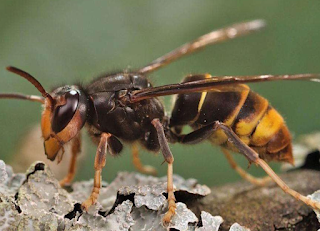Invasion Alert: Yellow-Legged Hornet Threatens US Honeybee Colonies
The United States is facing a new environmental threat as the Yellow-Legged Hornet, Vespa velutina, makes its presence known. This predator, larger than the typical yellowjacket and marked by its distinctive bright yellow legs, is notorious for its brutal method of capturing and butchering honeybees in mid-air, swiftly taking the most nutritious part—the thorax.
Origin and Spread According to recent reports, researchers have identified this invasive species originating from Afghanistan, eastern China, and Indonesia. Over the past two decades, the Yellow-Legged Hornet has expanded its territory, infiltrating South Korea, Japan, and Europe. The hornet's arrival in North America has raised significant alarm among environmentalists and agricultural authorities.
Impact on Honeybee Populations This hornet poses a severe threat to honeybee populations. It preys on bees, deterring foragers from leaving their hives, which leads to a significant decline in honey production and agricultural productivity. The European Union has even classified the Yellow-Legged Hornet as the first insect on its invasive species blacklist due to its devastating impact. Countries like Portugal and France have reported substantial losses in honeybee colonies, resulting in economic repercussions amounting to millions of dollars annually.
Case Study: The Invasion in Europe The Yellow-Legged Hornet invasion in Europe is believed to have begun with a single queen hornet that stowed away in a shipment of bonsai pots from China in the early 2000s. This single queen established a nest that produced dozens of new queens, which then spread rapidly across the continent. The narrative underscores the hornet's potential to wreak havoc on agriculture.
Response in the US With the first nest discovered in Savannah, Georgia, the state's agricultural commissioner has urged citizens to remain vigilant and report any sightings of this dangerous insect. Given the vital role pollinators play in supporting Georgia’s diverse agricultural sector, which is worth billions of dollars, swift action is essential.
Containment Efforts Scientists and agricultural authorities have responded promptly by deploying traps and conducting eradication efforts. By the end of the year, several nests had been located and neutralized, providing a glimmer of hope in containing the threat before it spreads further.
Conclusion The Yellow-Legged Hornet's presence in the US signals a dire need for heightened awareness and proactive measures to protect honeybee populations and, by extension, our agriculture and economy. Continued vigilance and prompt reporting can help mitigate this invasive species' impact.
FAQs
What is the Yellow-Legged Hornet? The Yellow-Legged Hornet (Vespa velutina) is an invasive predator known for its large size, bright yellow legs, and aggressive behavior towards honeybees.
Why is this hornet a threat to honeybees? It preys on honeybees by capturing them mid-flight and consuming their thoraxes. This behavior can decimate bee colonies, reduce honey production, and negatively impact agricultural productivity.
Where did the Yellow-Legged Hornet originate? It originates from regions such as Afghanistan, eastern China, and Indonesia. It has spread to South Korea, Japan, Europe, and now North America.
What are the economic impacts of this invasive species? The hornet has caused significant losses in honeybee populations in affected areas, leading to economic damages worth millions of dollars annually due to reduced honey production and crop pollination.
What measures are being taken to control its spread in the US? In Georgia, authorities have issued warnings and are encouraging citizens to report sightings. They have also deployed traps and conducted eradication efforts to contain the threat.
#InvasiveSpecies #YellowLeggedHornet #HoneybeeProtection #EnvironmentalThreat #AgriculturalImpact

